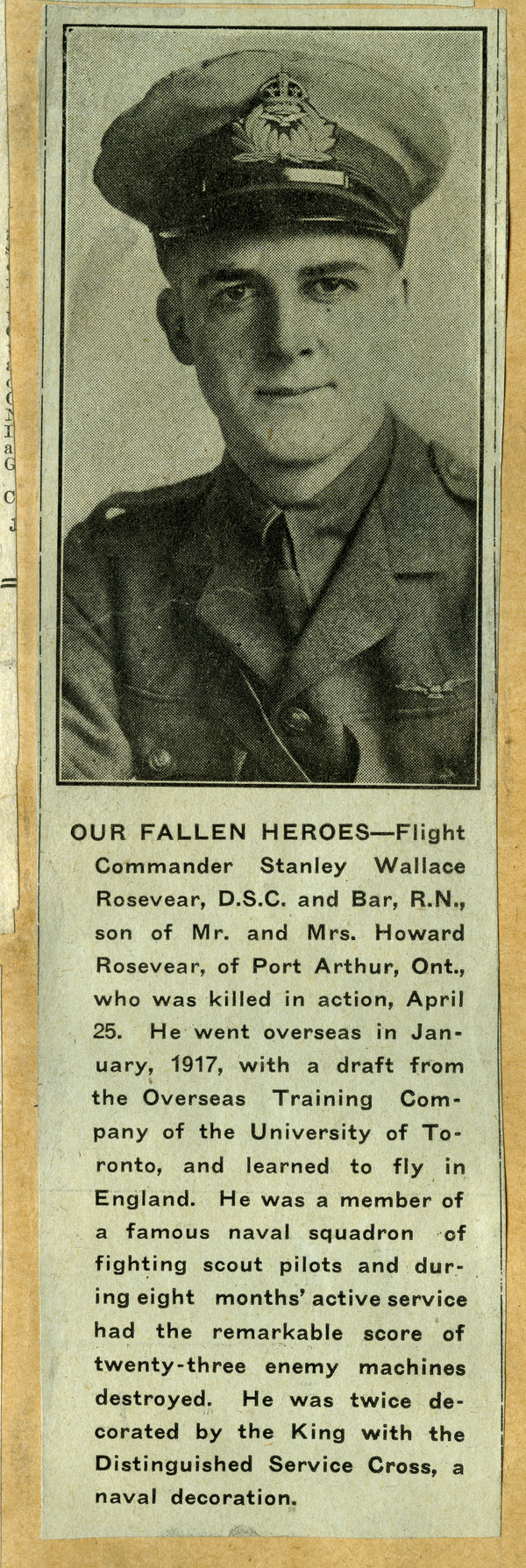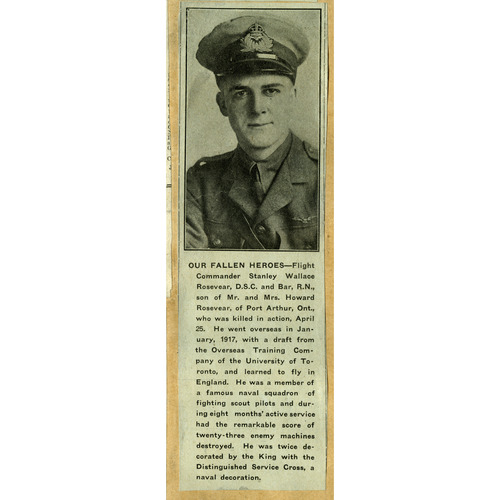
Source: Link
ROSEVEAR, STANLEY WALLACE, air force officer; b. 9 March 1896 in Walkerton, Ont., son of Howard Stanley Rosevear and Ella Maude Wallace; d. unmarried 25 April 1918 near Arras, France.
The son of a teacher, Stanley Wallace Rosevear was educated in Ontario at Lindsay Public School and Port Arthur Collegiate Institute. In 1915 he entered the University of Toronto to study applied science. He enlisted there in the Overseas Training Company in November 1916, and in January 1917 transferred to the Royal Naval Air Service, with the rank of probationary flight sub-lieutenant.
After going overseas in February, Rosevear trained in England at Redcar, Cranwell, Frieston, and Dover. He qualified as a scout pilot in June and then received his commission, which was backdated to April. In July he joined 1 Squadron of the RNAS, flying Sopwith Triplanes out of Bailleul, France.
During his nine months at the front, Rosevear was credited with 23 victories and was mentioned in dispatches three times. Described as a “very skilful and dashing fighter pilot,” he was awarded the Distinguished Service Cross for his work on 28 Oct. 1917 in “destroying several hostile machines” and attacking parties of enemy infantry from low altitudes, on one occasion from a height of only 100 feet. The squadron, in fact, gained a reputation among the Germans for its ground attacks, or “crawling patrols” as its diarist called them. Fully effective techniques and training programs for ground attacks, however, still had to be developed. German infantrymen were already being trained to use machine-guns against aircraft, with telling results, despite the skills of such aggressive pilots as Rosevear. “We paid for it in the pilots missing,” he commented in a letter to his parents in Port Arthur (Thunder Bay).
Promoted flight lieutenant on 1 Jan. 1918, Rosevear won a bar to his DSC on 15 March when, flying a Sopwith Camel, he attacked a formation of eight enemy aircraft, destroying two. He became a flight commander that month, and a captain in the Royal Air Force when the Royal Flying Corps and the RNAS were amalgamated on 1 April 1918 and 1 (N) Squadron became 201 Squadron, RAF. During the German offensive that spring he served at various points in the areas of Dunkirk, Bailleul, and Arras. He was shot down and killed over the Arras front on 25 April and was buried at Saint-Hilaire Cemetery, Frévent.
Rosevear’s obituary in the Toronto Evening Telegram claimed (wrongly, on more than one count) that next to Major William Avery Bishop* “he was probably Canada’s foremost aviator.” He was, however, certainly in the first rank of the fighter pilots of World War I.
AO, RG 80-2-0-432, no.3357. Can., Dept. of National Defence, National Defence Headquarters, Directorate of Hist. (Ottawa), Biog. file; Card index of Canadians in the British flying services, 1914–19. Evening Telegram (Toronto), 29 April 1918. Globe, 24 May 1918. London Gazette, 17 Nov. 1917, 17 April 1918. The official history of the Royal Canadian Air Force (3v. to date, [Toronto and Ottawa], 1980– ), vol.1 (S. F. Wise, Canadian airmen and the First World War, 1980). Univ. of Toronto, University of Toronto roll of service, 1914–1918 (Toronto, 1921).
Cite This Article
Brereton Greenhous, “ROSEVEAR, STANLEY WALLACE,” in Dictionary of Canadian Biography, vol. 14, University of Toronto/Université Laval, 2003–, accessed December 31, 2025, https://www.biographi.ca/en/bio/rosevear_stanley_wallace_14E.html.
The citation above shows the format for footnotes and endnotes according to the Chicago manual of style (16th edition). Information to be used in other citation formats:
| Permalink: | https://www.biographi.ca/en/bio/rosevear_stanley_wallace_14E.html |
| Author of Article: | Brereton Greenhous |
| Title of Article: | ROSEVEAR, STANLEY WALLACE |
| Publication Name: | Dictionary of Canadian Biography, vol. 14 |
| Publisher: | University of Toronto/Université Laval |
| Year of publication: | 1998 |
| Year of revision: | 1998 |
| Access Date: | December 31, 2025 |



